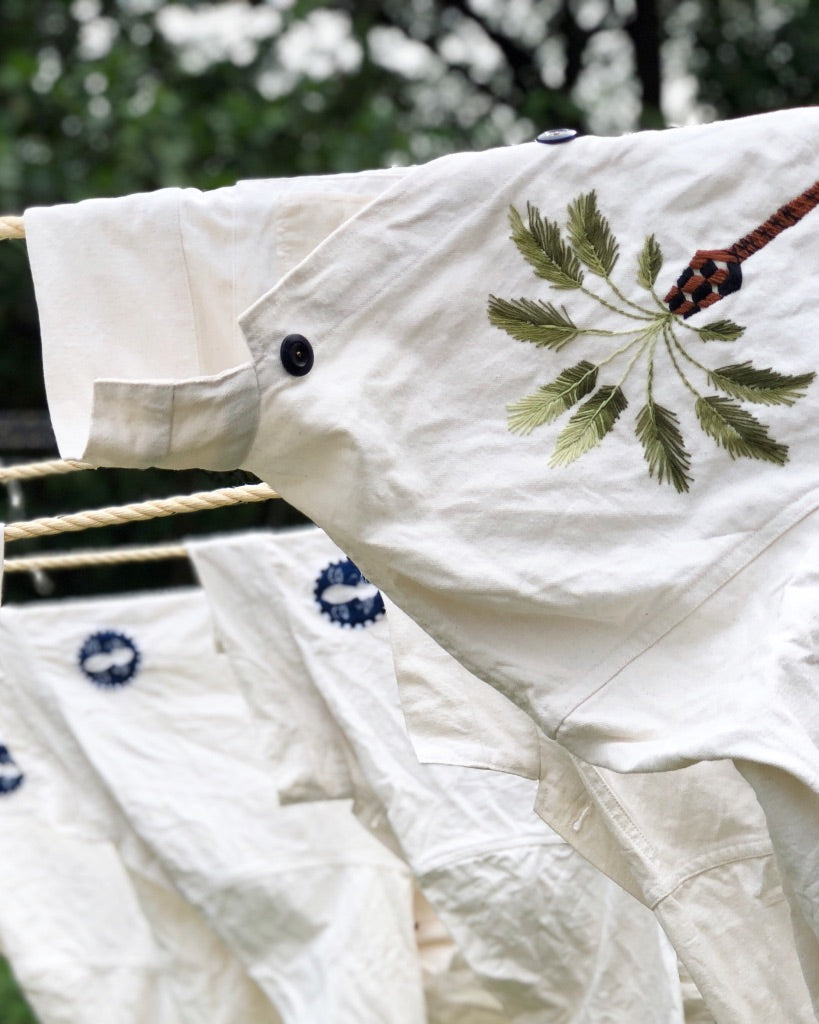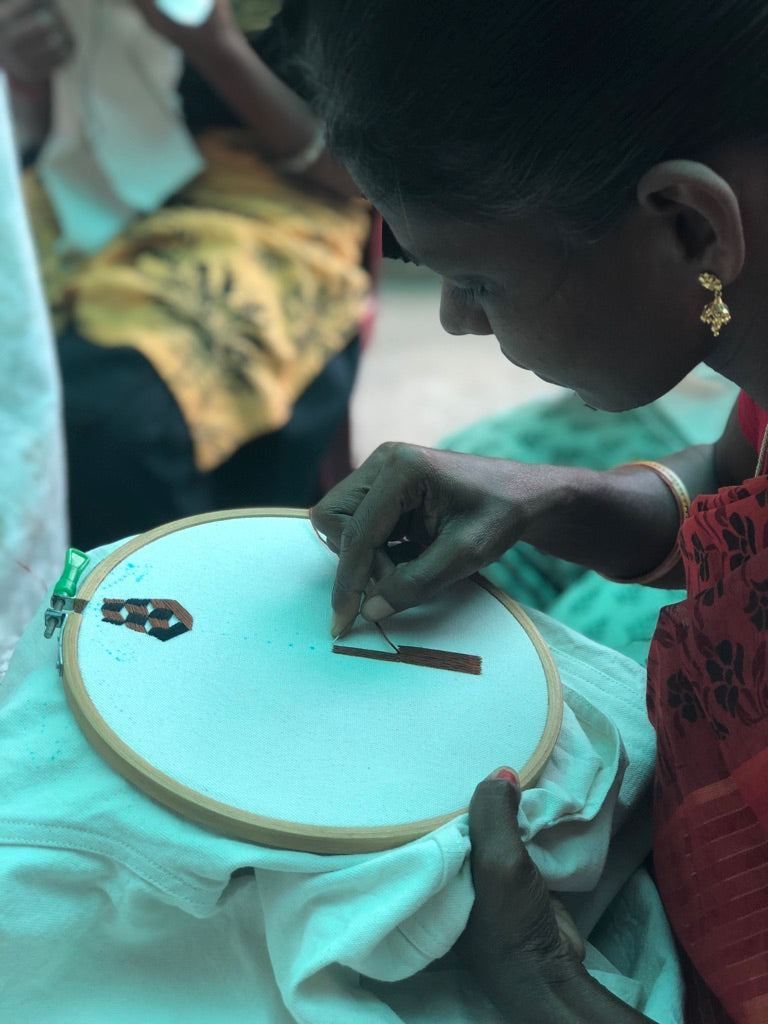STORY MFG.
Posted:
25 September 2018
Interview, Text & Intro: Martin Hufnagel
Pictures: Courtesy of Story mfg.
Recently, several fashion labels have entered the scene and have proved the important fact that fashion can be sustainable and look stylish at the same time. Story mfg. is one of them.
I met with Saeed, one of the two founders of the label. We talked about their way from making a pair of jeans to producing a whole collection, making 'positive products' in India and the current wave of 'sustainable' fashion.
From the very beginning, the clothes of Story mfg. have caught my eye. Not only did they seem special and more unique to me than the stuff you usually see in online shops, but they were also labelled as 'positive products', a term that made me want to know more about the brand's background. 'For us, the real important thing that we’re doing, that underpins everything is to create a better, ecological, sustainable way of making and selling clothes. That’s where we’re expending most of our efforts', explained Saeed, one of the label's founders, to me in a long phone conversation, which we had the other day.
Married couple Saeed and Katy founded Story mfg. together in 2013. Before that, Katy had worked at a trend forecasting company and was visiting a trading show. Saeed went with her, and that’s where they saw hand-loomed, natural dye, craft-based stuff that was either too expensive or too irregular. Usually both. 'We wanted items that didn’t exist. There was nobody making natural dyed stuff like we wanted to. If it had all the quality, it didn’t look as refined, sharp, and clean as we wanted it.'
They duo chose the name 'Story' not only because they liked the look of the word, but also because they had the idea to centre the brand around its manufacturing story. The 'mfg.' is a nod to older British and American companies.
From the start, Katy and Saeed travelled a lot to India. There they picked up their first fabrics and decided to make jeans to begin with. Initially, they planned to crowd-fund their project via Kickstarter, but the duo ended up proceeding independently. They set up a website and informed everyone about the launch date of Story mfg. From that point on, the stone began to roll.
'That was a super steep learning curve. Everything was late, we had to make a lot of changes of the pattern, but it was good. When the jeans were progressed, we made a jacket as well, called the Time Jacket. We never made the jeans again but the jacket, we make almost every season. Now there’s a short version too.' From early on, it became apparent that they would establish a range of products that would form the core of the Story mfg. collections. Saeed says, 'For me, when I find a brand that has been selling the same thing forever, then I feel like it says something about the enduring quality, the style of that piece. I feel like that really speaks to the brands heritage. So, every season, 80% is the same but we also like to cycle in new things, to keep it interesting.'
Even though Story mfg. have obtained their fabric from India since their inception, their first few seasons of clothes were made in the UK. 'That way we had control over it. We used a small tailor, we did a lot of hand-cutting here and at that time, I thought a "Made in England" label would be a selling point. But at one point, it started to get to us: We’re doing all of this stuff, we use recycled water, we’re using natural dyes and organic cotton, but then, we fucked it up by flying it all from one country to another. So, we decided to set up our thing in India. I thought people would have a problem with Story mfg. going from Made in England to Made in India, but nobody cared.'
Through a contact Katy and Saeed were told about a community project there. 'It’s like a commune, except it’s completely religionless. Like a cult, without the cult', explains Saeed. Here they were able to connect with other people and find skilled workers for their clothes. When he describes Story mfg.'s set-up there, Saeed explains, 'Now it's like our dream. You can spit from the tailors to the dyers.' He describes that there is a dying pit and an indigo pit. Upstairs, there are the tailors and downstairs there is the administration, and in the garden next door, are all the embroiderers. 'I do understand that people worry about working conditions in other countries, but I can tell you that our factory in India is better than any place I’ve worked in myself.'
The experimental community is also the home of people who are doing ecological research. 'There’s a guy, Jesus, who settled here. He started this natural dye unit in the 80s or 90s. It’s completely pure, he’s fanatical about that. There are no chemicals. We worked with him to do our natural dyes for Story mfg., developing our fabric and so on.'
It’s a heartfelt desire for Saeed and Katy to give their clothes colour without using any sulphites or chemicals. Natural dyes are dyes or colorants derived from plants or minerals, while synthetic dyes are chemically manufactured. Natural colours look and behave differently. For example, a natural red is not just a pure red, but includes blue and yellow. Therefore, it looks different in every light. When you’re wearing an item from Story mfg., you can observe and actually feel that. It’s a science of its own to mix colours to get the specific shade that you want. Sometimes it takes a lot of time and attempts to get there. This is why the experience and knowledge of someone like Jesus has become essential.
According to Saeed, natural dying is better for the earth. 'For example, we use indigo that’s grown locally. In India it’s used by farmers to balance the soil. All our other dyes are from India. But if you were to use a chemical fixative throughout this process it’s much worse for the earth, because you need way more water.'
The ambition to create 'positive products' that last for a long time, to use natural dyes, and to maintain this philosophy throughout everything that’s connected with Story mfg. is a hard and challenging road. 'We constantly keep each other in check. Sometimes I’m like, "It would be so much easier to send this in plastic", and then Katy is like, "No, we’re not using plastic."'
That’s why the packaging that the Story mfg. clothes come in is biodegradable. 'It took us about 3 years to get to that point. As a small business, you have to work your way up to that point. We still have challenges, for example, we just addressed our paper problem.' They were buying paper, but now they're making labels from their old clothing. 'Our really big challenge is to figure out how we can transport stuff to stores like The Wasted Hour. That’s a really difficult question. We’re not 100% conscious, but we’re all working towards a better system.'
When talking to Saeed, it becomes clear that for Story mfg. sustainability is not just a shallow word or a marketing trick. In the past few years, terms like 'sustainability', 'slow made' or 'eco-fashion' have been adopted by many brands to ride the green wave, to sell their stuff and create a conscious image for themselves.
Saeed is not sure what to think about this development. 'I have so many thoughts about this, but I don’t know where to place myself. On the one hand, as long as things are moving in the right direction, then we’re going the right way. I shouldn't really criticise because as long as we’re moving, things will be better and better. But on the other hand, yeah, absolutely, it’s kind of sucky. Sustainability is such an open term. Personally, I think there are practices that can never be sustainable. Nevertheless, I do find it hard to criticise, because people are making some kind of effort.'
It’s the hope that this trend creates awareness and a starting point for people from where they can dive deeper into the topic and look behind the empty phrases. Dealing with the fair-trade fashion scene, you sometimes get the impression that it’s a battle-ground for people fighting over things like the use of cotton in general, or claiming to own the truth instead of combine their efforts to create a better place. Therefore, it’s refreshing to hear that Story mfg. looks at the bigger picture and focuses on evolving and creating beautiful, unique items.














